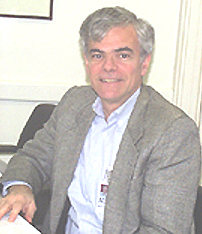
| T H E N I H C A T A L Y S T | M A R C H – A P R I L 2007 |
|
|
|
| FROM THE DEPUTY DIRECTOR FOR INTRAMURAL RESEARCH |
TURNING
MEDICAL STUDENTS
INTO PHYSICIAN-SCIENTISTS
 |
| MICHAEL GOTTESMAN |
On Saturday, March 24, NIH co-hosted a 10th reunion for members of the Clinical Research Training Program (CRTP). The CRTP was established at the recommendation of the NIH Director’s Clinical Research Panel in 1996 to address concerns that medical students were not being exposed to clinical research opportunities or classroom training in the discipline of clinical research as part of their medical school curriculum.
I am pleased to report on the progress of this and other programs at NIH, including the long-standing Howard Hughes Medical Institute (HHMI)-NIH partnership, that provide medical students with the research experiences that may inspire a career as a physician-scientist.
The Seeds of Success
Clinical research training has been championed by NIH directors throughout most of NIH’s history, and NIH has a proven track record of turning physicians into outstanding scientists. Approximately half of the winners of the Nobel Prize in Medicine or Physiology in the past 25 years who have M.D. degrees got their primary research training at NIH. By any measure, this is a spectacular record for a single institution.
The talent that led to this success came to NIH largely as a stream of physicians during the period encompassing the Korean and Vietnam wars. Many at NIH, including our former Director Donald Fredrickson, became concerned as this torrent turned into a trickle in the 1980s.
So Fredrickson, when he became director of the HHMI, set as a high priority the establishment of a residential program at NIH for medical students after their second year of medical school to spend a year in NIH laboratories.
This HHMI–NIH Research Scholars program, now in its 21st year, has enrolled 863 students, the majority of whom have careers in academic medicine and biomedical research. Many have returned to NIH and some are part of our faculty.
The CRTP was intended to fill a similar gap for physicians-in-training who were interested in clinical research. To date, 190 students have been enrolled, and 109 participated in the reunion activities.
The morning program offered inspiring and informative lectures from six institute directors; the afternoon discussion by some of the more senior graduates recounted the joys and tribulations of pursuing clinical research careers.
Aims: To Achieve Balance and to Segue Gracefully
The most senior of these students are entering the chasm that lies between a completed clinical fellowship and a faculty position. A few are back at NIH, but most are dealing with the tug of clinical practice vs. their academic and research interests.
It is a delicate balance, and many institutions are reluctant to provide the necessary protected time needed to develop research projects for trained physicians who could be earning their keep by practicing medicine and surgery.
Another product of the 1996 Clinical Research Panel was the development of K awards (especially the K23) to support clinical research activities and supplement the existing K08 award for mentored laboratory research. Recently, HHMI has added a competitive start-up grant for which former HHMI research scholars may apply.
These are the mainstay of support for physician-scientists in the extramural world making the transition to independence. In the intramural program, this gap between training and independence for clinical researchers remains to be filled.
In response to recommendations of a blue ribbon panel on clinical research in 2005 and enthusiastic support from the Advisory Board for Clinical Research, NIH as a whole, and several of our institutes, are developing transition positions, such as the associate clinical investigator, to support independent clinical research as a bridge to a tenure-track position.
The reunion highlighted the enormous success of the CRTP in training medical students for clinical research careers, but it also made us think more about how to ease the transition from training to full independence as a faculty member at NIH or at an academic medical center. Creating meaningful and effective career tracks for clinical investigators must be a continuing priority for NIH.
—Michael
Gottesman
Deputy Director for Intramural
Research